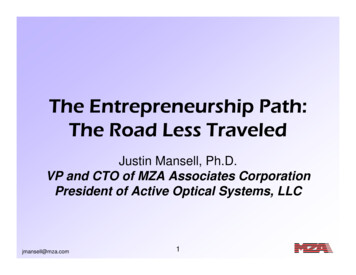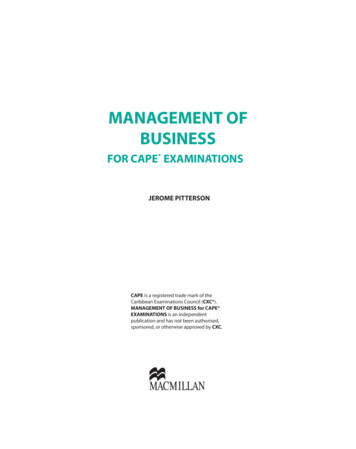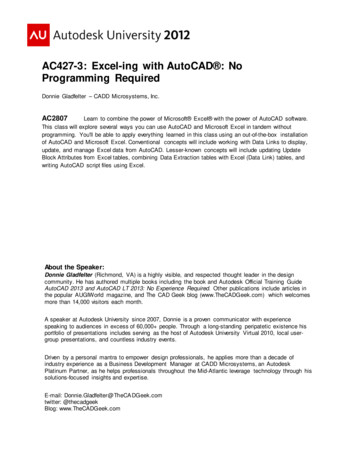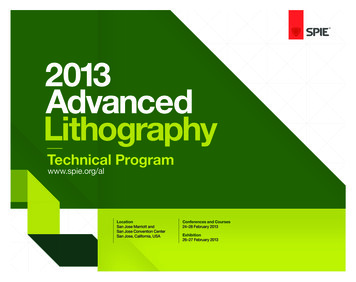
Transcription
The Entrepreneurship Path:The Road Less TraveledJustin Mansell, Ph.D.VP and CTO of MZA Associates CorporationPresident of Active Optical Systems, LLCjmansell@mza.com1
Outline My Path to Entrepreneurship Beginning Your Entrepreneurship Journey– Introduction– Creating a Business Plan– Beyond the Plan Conclusions Example Pitchjmansell@mza.com2
My Entrepreneurship Path(so far)jmansell@mza.com3
Brief Resume 1991-1996: Computer Consultant1993-1996: Internships1995-1996: Research Consulting1996-1999: Wavefront Sciences1996-2001: RA at Stanford University1999-2001: Optics Consultant2000: Stanford e-challenge2000-2002: Founder/CTO at Intellite, Inc. (AgilOptics)2002-present: Mansell & Associates, LLC2002-2003: Chief Engineer at Qynergy Corporation2003-present: VP and CTO at MZA Associates Corp2005-present: President of Active Optical Systems, LLCjmansell@mza.com4
1991-1996: Computer Consultant During my undergraduate, I worked parttime as a consultant, mostly on computerdatabase development.––––ATM AccountingMedical Doctor Professional Society DatabaseSecurity System for Cleveland Museum of ArtProbate Court Case Tracking Database Lessons Learned:––––Project ManagementBilling & InvoicingTracking TimeImportance of Customer Relationships New Biz through Customer Recommendationsjmansell@mza.com5
1993-1996: Internships NASA Glenn– Developed the control system for the ISS PlasmaContactor Sandia National Labs– Data reduction from Tri-Axial CompressionExperiments– Shack-Hartmann Wavefront Sensing and Micro-Optics Lessons Learned––––How to solve problems independentlyBeing part of a research teamValue of experienceLarge amount of fertile ground at the intersectionbetween almost any two fields– Value of Intellectual Property (IP) and how to protect itjmansell@mza.com6
1995-1996: Independent Researcher After my SNL internship, I got back to CWRUand found the research path outlined by myresearch advisor unappealing. I pitched doing an independent research projectfor my MS Thesis that involved– Developing software for automation of mask patterngeneration.– Demonstrating a technique for improving micro-opticsperformance. Pitched this to SNL and got it funded. Lessons Learned– Think creatively about education (you don’tnecessarily have to do things traditionally)– How to write a proposal.– How to develop a credible project plan and budget.jmansell@mza.com7
1996-1999: Wavefront Sciences As I was leaving SNL to go to Stanford for myPh.D., my SNL boss was leaving to try a start-upcalled Wavefront Sciences (WFSI). I agreed to work part-time on IR&D, softwaredevelopment, and micro-optics development. Lessons Learned–––––How to start a business (peripherally)How to productize (peripherally)How to manage research (remotely)Really being part of a research teamBe creative in working deals: We traded a wavefront sensor we could not afford for aCRaDA with WFSI.– Small businesses can be a lot of fun!jmansell@mza.com8
1996-2002: RA at Stanford Worked on numerous projects including––––MEMS SpectrometerMEMS Deformable MirrorsWavefront SensorsLow-Cost AO for Lasers Lessons Learned–––––How to Write & PresentEngineering EthicsSafety Policies and ProceduresWorking CollaborativelyManaging Expectations (“Upwards”)jmansell@mza.com9
2000-2002: Intellite / AgilOptics Founded Intellite to commercialize the MEMSdeformable mirrors we developed at Stanford. Pitched Intellite at a Venture Capital Symposium Lessons Learned– Productization (manuals, packaging, etc.)– Writing a business plan What do VCs care about How to sell to them– How to roll with the unexpected Intellite had to change its name due to legal pressurejmansell@mza.com10
2002-Present:Mansell and Associates Founded to do engineering and IPconsulting Lessons Learned– You really can do it all yourself– You may not really want to Having a team really does help!jmansell@mza.com11
2002-2003: Qynergy Business founded to commercialize technology inventedat SNL for radioisotope energy generation Strategy was to “top-load” the team– Lots of Grade A Management, but light on the technical team Lessons Learned– Research How to work limited resources Managing research outside of my expertise “A 90% solution now is better than a 100% solution later”– Business The costs and benefits of a high-quality team IP Development & Protection Business Plan Developmentjmansell@mza.com12
2003-Present: MZA Associates Primarily DoD consulting firmspecializing in detailed physicslevel modeling of defense opticalsystems. MZA has grown from 1 office of 15 people to 3 offices of 35people in the last 4 years Lessons Learned (and Learning)– Managing Growth– How to Transition from a Small to aMedium-Sized Companyjmansell@mza.com13
2005-Present: Active Optical Systems Spin-off of MZA founded tocommercialize a new low-costAO technology Lessons Learned (& Learning)– Unusual Funding Sources– Leverage Existing Technology– Luck MattersPolymer Membrane Under12 kW CW 1-µm Lightwww.aos-llc.comjmansell@mza.com14
Getting Started as anEntrepreneurjmansell@mza.com15
Limitations & Caveats People spend their life studying this topic.– I will only have time to present some of the basics. I have no formal business school training. There are many books and much literature onthis topic, including:– The Start-up Entrepreneur, J.R. Cook– Entrepreneurship For Dummies, Kathleen Allen– Outline for a Business tlinefor a Business Plan.pdf)jmansell@mza.com16
Entrepreneurs Identify business opportunities(spark) Create a plan to capitalize onthe opportunity (diligence) Find the resources (marketing) And (sometimes) execute theplan (leadership)jmansell@mza.com17
New Business Idea Quick Test:Should I be an Entrepreneur? Am I excited about this idea or opportunity?– E-ink ideas Do others also think it’s a great idea? Are there people willing to pay for what I’moffering? Why am I the right person for this? Why should I go forward with this idea oropportunity now?– Diode Laser vs. HeNe for Barcode ScannersEntrepreneurship for Dummies, Kathleen Allenjmansell@mza.com18
The Business Planjmansell@mza.com19
Business Plan Basics A business plan is like a job application tobecoming an entrepreneur. A well-written business plan forces theauthor to evaluate the idea in sufficientdetail to sell it and/or guide thedevelopment of the resulting business. Reasons for Writing a Business Plan:– Organizes and Structures the Business toCapitalize on the Opportunity– Sells the Opportunity to Investorsjmansell@mza.com20
Comments on Investors Investors should be thought of as members of yourteam.– What assets (other than financial) do they bring to the table? Investors are not stupid, – Would you want them on your team if they were? especially about business– How do you think they got that money to invest? Investors are looking for a substantial increase in thevalue of your venture (5-10x) in a fairly short period (5years)– Success Stats are Dismal, but ask, “What is success?” Investors generally won’t sign NDAs Investors might be considering other deals in yourspace. Its generally OK to ask them this question. Investors often care more about team than opportunity.– Experience more than educationjmansell@mza.com21
Components of a Business Plan The Opportunity– Product / Service– Industry & Market Analysis– Competitive & SWOT AnalysisFlip in theFinal Version The Team– Management– Company Description The Plans & Projections– Financial (including projections), Marketing,and Operatingjmansell@mza.com22
Product / Service Coming from a technical background, I like towrite this first and then write the industry partsecond, but switch the order for the investors. Describe the product or service in detail. Focus on the distinguishing features. Compare to the existing solutions.– There are always existing solutions. Give as much detail as you feel comfortablereleasing publicly– Investors often won’t sign NDAs Include a description of existing or applied for IP– Investors generally discount provisional patentsjmansell@mza.com23
Industry & Market Analysis There can be multiple industries or applications, but often targetingmore than one at a time may not be possible given resources, sochoose one & prioritize the others.Find as much data as possible on the industry and market segmentincluding– Size (dollars and units)– Recent and Projected Growth Rate (especially in your segment)– Location (where is the money spent?) This data can be hard to come by, but look––––– On the internetIn relevant trade journalsIn the local business school libraryAt Technology Venture Corporation (TVC)Customer Surveys (keep good records)This part can be the hardest part for technologists, so don’t be afraidto ask for help.– Investors will most likely be better than you at this, so spend the time toget it right.jmansell@mza.com24
Competitive Analysis Who else out there is doing something thatcompetes in any way?– Important because it could be a hiddenopportunity Why would their customers become yourcustomers? A comparison table is often useful here.jmansell@mza.com25
SWOT Analysis Strengths, Weaknesses, Opportunities,and Threats Try to be as realistic and objective aspossible Include global considerations. You may have done this throughout theother portions, but investors aresometimes looking for this as a summary.jmansell@mza.com26
The Team Investors generally weigh this moreheavily than the opportunity– “I’d rather have an A team with a B idea thana B team with an A idea” Experience is key They will be looking for a coremanagement team with all the key areascovered and ideally with experience.– Address any key weaknesses (What you don’thave you might hire.)jmansell@mza.com27
Plans and Projections Tie these back to the industry data asmuch as possible. Investors generally won’t believe ridiculousmarket share predictions, so be realistic. Create a budget of how you think moneywill be spent.– include a detailed budget if you’re asking forinvestment.jmansell@mza.com28
Beyond the Business Planjmansell@mza.com29
The 5-Minute (Elevator) Pitch Once the business plan is complete, it isimportant to write down and rehearse a 5minute pitch of your business Touch on:– Product/Service– Industry & Market– Potential for Growth– Management Teamjmansell@mza.com30
Types of Investors Government (Grants / SBIRs)– No equity cost– Not just the USA either Other Corporations– Small and Large Angel Investors– Small and early round investors Venture Capitalists– Typically 1M investment– Significant equity costjmansell@mza.com31
Entrepreneur’s Skills ManagementLegalIntellectual PropertyMarketingAccountingHuman RelationsInsuranceWorkman’sCompensation &Unemployment Taxjmansell@mza.comYou don’t have tobe an expert in allof these areas, butif you’re going tolead the team, youneed to know a bitabout all of them.32
Conclusions Entrepreneurs capitalize on businessopportunities. Getting started means writing a plancovering the:– Opportunity, Team, & Plan & Projections. The plan will guide your company and helpyou hook investors.jmansell@mza.com33
Example Pitch:Active Optical Systems, LLCjmansell@mza.com34
Problem: Optical DistortionsApplication /Market Segment1. LasersEffect of Distortions2. PhotolithographyReduced Feature Sizesand Resolution3. OphthalmologyMissed Diagnoses4. Free-SpaceCommunicationsLarge Bit Error Rate andLost Data5. Optical DataStorageLower Data DensityLarger Spot SizeReduced Intensity6. Telecommunications Signal Degradationjmansell@mza.comHuman RetinalImage35With DistortionsDistortions Gone
Laser AO Market Opportunity Laser Market ( 2B)– Large High-Growth Market 2B in 2000 with 10% growth– High Product Cost ( 100k)– Industry Contacts & Contracts Laser Adaptive Optics– OEM Segment for AO 240 Million (2001) 500 Million in 7 years– End-User Segment for AO 140 Million (2001)– Estimated 380M AO SystemRevenue Potential by 2012jmansell@mza.com36NOTE: Numbers here arenot necessarily traceable toresearch.
Example: Photolithography Masks Electron Beam Written MasksE-beam Mask Writer– Higher Resolution– Mask Cost: 3,000 to 20,000 Laser Beam Written Masks– Higher Productivity– Mask Cost: 300 to 1,500 Benefits of Laser AO– Mask Maker Electron Beam quality Laser beam cost– Laser Manufacturers New Sales Possibilitiesjmansell@mza.comLaser Mask Writer37
AOS’s Adaptive Optics ProductBeforeAOS’s irrorSensorBenefits to OEM and End-User AOS’s Competitive Edge Reduces Laser Cost Polymer DM Increases Intensity Significantly Reduced Cost Opens New Application Doorswith Higher Volumejmansell@mza.com38
AOS Component TechnologiesDrive ElectronicsWebcam HartmannSensorPolymer DeformableMirror(patents pending)jmansell@mza.comDM Before Packaging39
Competitive AnalysisCompetitorAnalysisCompany AMEMS-based (costly 50k)High Power Laser CapableSlow Growth Strategy (CEO is a Professor)Products Need Engineering (not turn-key)Company BLimited in sizeLimited Laser Power HandlingHigh Cost ( 100k for DM Electronics)Company CFocusing on the Ophthalmology MarketHigh Cost ( 75k for DM Electronics)Cannot handle high power lasersAOSLow Cost ( 6.5k DM Electronics, 7.5k Systems)Turn-key Systemsjmansell@mza.com40
Management Team Justin Mansell-President– Ph. D. from Stanford Univ. in adaptive optics forhigh power laser wavefront control– 10 years of Technical and Business Start-upExperience Robert Praus & Steve Coy – VPs– Each has 20 years of experience in developingand modeling high power laser systems for DoDapplications Defining Marketing and COO Positionsjmansell@mza.com41
Experience(2005)MEMS FTSpectrometer (2000)US Patent6,707,020 (2004)Delay Line M2Meter (2001)Gaussian to Top-HatBeam Shaping(2000)Boeing Relay MirrorAO Testbed (2004)MOPA AO(2000)Knife Edge SHWFSUS Patent6,376,819 (1999)Binary OpticsSmoothing (1996)US Patent5,864,381 (1999)(1998)Mini-Cass (2001)US Patent 6,108,121 (2000)ApodizedMicrolens Arrays(1999)(1996)(1991)jmansell@mza.com42
Millon70605040Financial Projections Seeking 1M in Start-up Capital Break-Even in Year 3 60 M Revenue by Year nt Year435
Questions?Justin Mansell, Ph.D.jmansell@mza.com(505) 245-9970 x122jmansell@mza.com44
for_a_Business_Plan.pdf) jmansell@mza.com 17 . Entrepreneurship for Dummies, Kathleen Allen. jmansell@mza.com 19 The Business Plan. jmansell@mza.com 20 Business Plan Basics A business plan i










